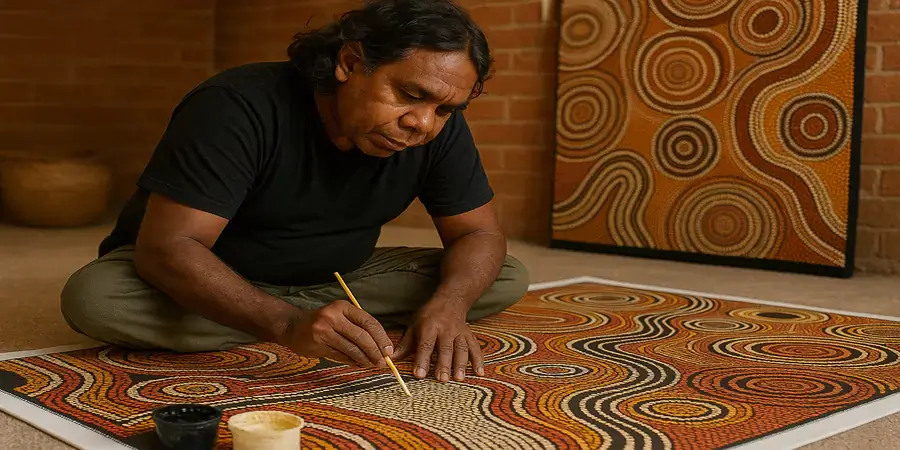When most people hear “Aboriginal art,” their minds often jump to dot paintings and vibrant canvases hanging in galleries. But Aboriginal art is far more than just beautiful paintings—it’s an ancient form of storytelling, a cultural archive, and a spiritual connection to the land. With roots dating back over 60,000 years, it is one of the oldest continuous artistic traditions in the world.
In this article, we explore why Aboriginal Art goes beyond the canvas and holds a deeper cultural, spiritual, and historical significance for Indigenous Australians.
A Living Language of Symbols
Aboriginal art uses a rich vocabulary of symbols to tell stories about “The Dreaming”—a foundational belief system that explains the creation of the world, ancestral beings, and the interconnectedness of all life. These symbols are not just decorative. Each shape, color, and pattern carries specific meanings that vary between different communities and language groups.
For example, concentric circles might represent a waterhole, a meeting place, or even a sacred site. Footprints can signify travel, and wavy lines often depict water or ancestral paths. Understanding these symbols reveals that every piece of Aboriginal art is a narrative—often layered and multidimensional.
More Than Canvas: A Variety of Mediums
While acrylic paintings on canvas have become internationally recognized, Aboriginal art exists across many mediums:
- Rock art: Found across Australia in places like Kakadu and the Kimberley, Aboriginal rock paintings are tens of thousands of years old. They depict stories, ceremonies, and animals, preserving history on the walls of caves and cliffs.
- Body painting: Used during ceremonies and rituals, these artworks are temporary but deeply significant, often connected to the totemic identity of the person wearing them.
- Weaving and sculpture: Aboriginal people use natural materials to create baskets, fish traps, and carvings that hold both practical and spiritual value.
- Sand and bark art: These ephemeral and organic forms of expression are traditional and region-specific, often linked with ceremonial use.
This diversity underscores that Aboriginal art is not confined to galleries—it’s embedded in daily life, spiritual practice, and the natural environment.
Spiritual Connection to Country
“Country” in Aboriginal culture refers not just to land, but to a living entity with which people have a deep spiritual relationship. Aboriginal art often maps this connection. Unlike Western landscape painting, these artworks are not meant to be realistic portrayals but rather spiritual and cultural maps passed down through generations.
By creating art, Aboriginal people maintain their bond with ancestors, law, and place. It’s a form of cultural survival and resistance that preserves knowledge, identity, and belonging.
Cultural Protocols and Respect
It’s important to understand that not all Aboriginal stories are for public sharing. Many artworks are created with permission from Elders and follow strict cultural protocols. Some stories are “men’s business” or “women’s business,” and only certain individuals are allowed to represent them artistically. This ensures that the art remains a respectful and authentic expression of community values.
Conclusion
Aboriginal art is much more than just paintings—it is a visual language, a cultural archive, and a spiritual lifeline. Each piece reflects a deep connection to heritage, identity, and the land. Whether etched into rock, painted on a canvas, or woven from grasses, Aboriginal art continues to be a powerful way for Indigenous Australians to share their stories, protect their traditions, and assert their presence in the modern world.













